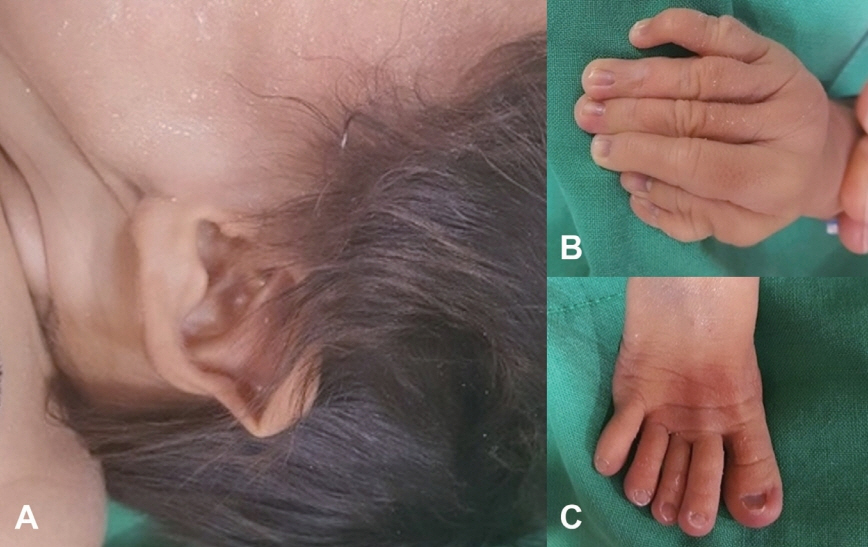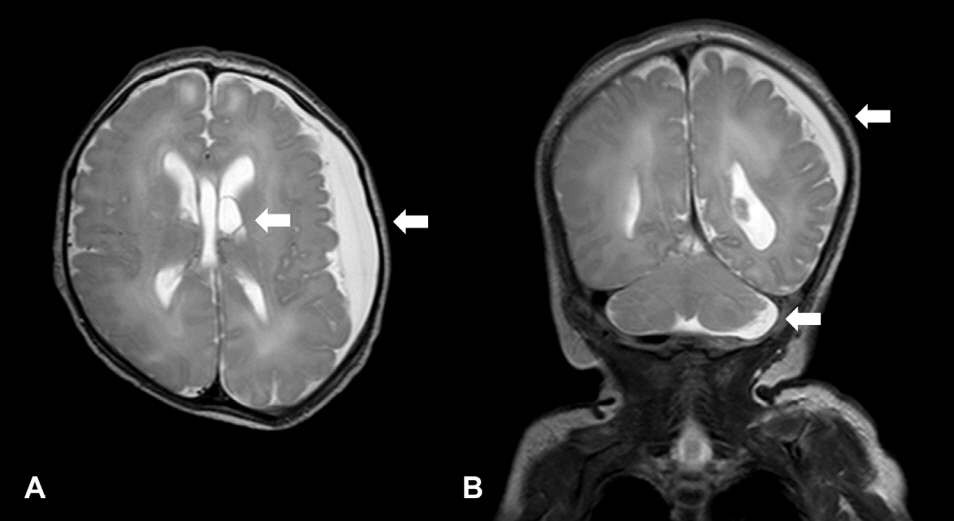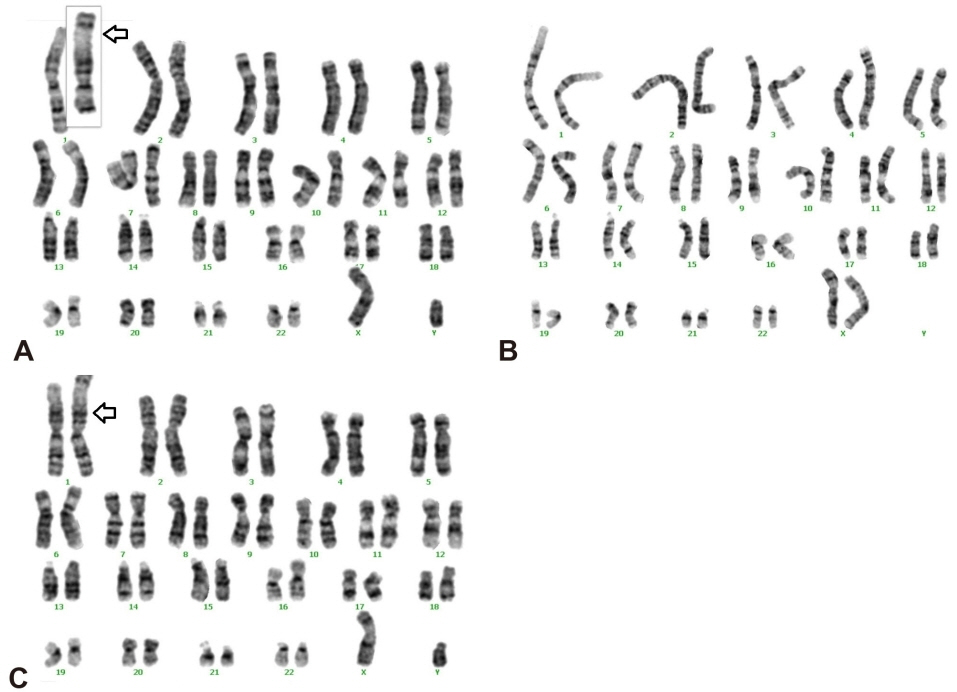Neonatal Med.
2022 May;29(2):91-95. 10.5385/nm.2022.29.2.91.
Developmental Delay and Rehabilitation in an Infant with Partial Trisomy 1q32.1 to 1q44: A Case Report
- Affiliations
-
- 1Department of Pediatrics, Chung-Ang University Hospital, Chung-Ang University College of Medicine, Seoul, Korea
- KMID: 2530612
- DOI: http://doi.org/10.5385/nm.2022.29.2.91
Abstract
- Partial trisomy 1q is a rare chromosomal disorder characterized by ventriculomegaly with craniofacial, renal, cardiac, and finger and toe anomalies. Most reported cases of partial trisomy1q have involved stillborn or premature deaths due to cardiac or liver failure. This case report describes an 18-month-old patient with partial duplication of the 1q32-44 segments and consequent developmental delays who exhibited improvement in developmental status with rehabilitation. Prenatal ultrasonography and magnetic resonance imaging of the mother revealed ventriculomegaly and atrophic changes in the left cerebral hemisphere of the fetus. The infant was born with micrognathia, microphthalmia, macrocephaly, low-set ears, polydactyly, and long feet at 37+5 weeks of gestation. A chromosomal study revealed an abnormal male karyotype of 46,XY,rec(1)dup(1)(q32.1q44)inv(1)(p36.3q32.1)pat. In this rare case of a patient with partial trisomy, we observed improvement in developmental delays following treatment using appropriate rehabilitation techniques. Further research is required to help validate the findings of this case study and establish a standardized rehabilitation technique that can be subsequently applied to such cases.
Figure
Reference
-
1. Utine GE, Aktas D, Alanay Y, Gucer S, Tuncbilek E, Mrasek K, et al. Distal partial trisomy 1q: report of two cases and a review of the literature. Prenat Diagn. 2007; 27:865–71.2. Cocce MC, Villa O, Obregon MG, Salido M, Barreiro C, Sole F, et al. Duplication dup(1)(q41q44) defined by fluorescence in situ hybridization: delineation of the ‘trisomy 1q42-->qter syndrome’. Cytogenet Genome Res. 2007; 118:84–6.3. De Brasi D, Rossi E, Giglio S, D’Agostino A, Titomanlio L, Farina V, et al. Inv dup del (1)(pter-->q44::q44-->q42:) with the classical phenotype of trisomy 1q42-qter. Am J Med Genet. 2001; 104:127–30.4. Bartsch C, Aslan M, Kohler J, Miny P, Horst J, Holzgreve W, et al. Duplication dup(1)(q32q44) detected by comparative genomic hybridization (CGH): further delineation of trisomies 1q. Fetal Diagn Ther. 2001; 16:265–73.5. Kimya Y, Yakut T, Egeli U, Ozerkan K. Prenatal diagnosis of a fetus with pure partial trisomy 1q32-44 due to a familial balanced rearrangement. Prenat Diagn. 2002; 22:957–61.6. Duba HC, Erdel M, Loffler J, Bereuther L, Fischer H, Utermann B, et al. Detection of a de novo duplication of 1q32-qter by fluorescence in situ hybridisation in a boy with multiple malformations: further delineation of the trisomy 1q syndrome. J Med Genet. 1997; 34:309–13.7. Lungarotti MS, Falorni A, Calabro A, Passalacqua F, Dallapiccola B. De novo duplication 1q32-q42: variability of phenotypic features in partial lq trisomics. J Med Genet. 1980; 17:398–402.8. Nowaczyk MJ, Bayani J, Freeman V, Watts J, Squire J, Xu J. De novo 1q32q44 duplication and distal 1q trisomy syndrome. Am J Med Genet A. 2003; 120A:229–33.9. Bonaglia MC, Giorda R, Poggi G, Raggi ME, Rossi E, Baroncini A, et al. Inverted duplications are recurrent rearrangements always associated with a distal deletion: description of a new case involving 2q. Eur J Hum Genet. 2000; 8:597–603.10. Morris ML, Baroneza JE, Teixeira P, Medina CT, Cordoba MS, Versiani BR, et al. Partial 1q duplications and associated phenotype. Mol Syndromol. 2016; 6:297–303.11. Sillen A, Wadelius C, Anneren G. Boy with an interstitial 1q (q31q41) duplication confirmed by fluorescent in situ hybridisation. Am J Med Genet. 1998; 80:163–8.
- Full Text Links
- Actions
-
Cited
- CITED
-
- Close
- Share
- Similar articles
-
- Rare Occurrence of Internal Auditory Canal Stenosis Accompanied With Congenital Facial Palsy in a 3-Month-Old Infant: A Case Report
- A De Novo Unbalanced Translocation t (5;7) (q33;p22) Carrying Partial Trisomy 5q and Partial Monosomy 7p
- A Case of Distal 10q Partial Trisomy Syndrome
- Rehabilitation Treatment of a Child Diagnosed With Duplication of 1q42-q44: A Case Report
- A Case of Chromosome 1q44 Deletion with Microcephaly and Multiple Congenital Anomalies




